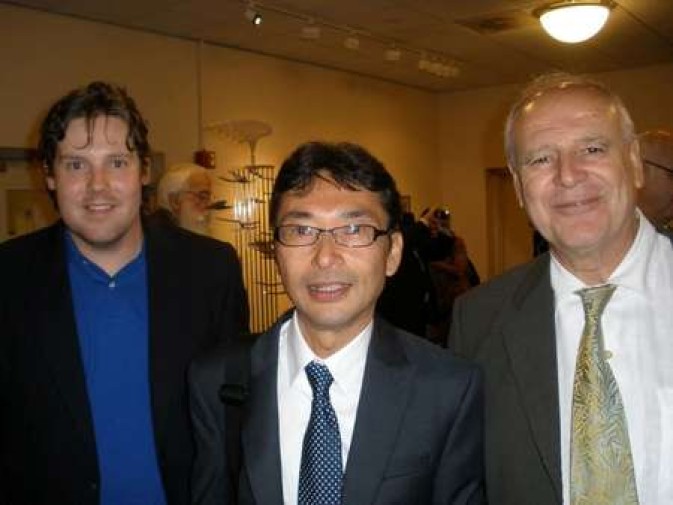Maxwell Stillwell, Bon Koizumi & Takis Efsathiou
Letter from Maxwell Stillwell to Takis Efstathiou
Date: October 25, 2012
Dear Mr. Efstathiou,
This is Maxwell whom you met recently in New Orleans. May I call you Takis?
It was truly a pleasure to meet someone so active in the realm of Hearniana as yourself. I traveled to New Orleans for the sole purpose of the Tulane exhibit. Please allow me to describe myself in a bit more detail than the cramped New Orleanian bus allowed us opportunity for.
I graduated several years ago from Indiana University with a degree in East Asian Studies. My emphasis was Japanese language, though I graduated before I could call myself more than barely conversant. For me, the first time I heard the name Hearn was when my Professor of Japanese History wrote the name on the blackboard at Indiana. Also on the board was written the title Glimpses of Unfamiliar Japan. And upon my looking up the book, I was immediately hooked. For my last semester I chose classes that would allow me to study 19th century American Literature so that I could overlap my interests with my requirements. In the last few years I have worked at various jobs, taking every free moment to continue my Hearn studies.
Recently my collection of Hearn books has grown to about sixty-five, as you read in my notebook on the St. Charles streetcar. That day I was also very impressed with Professor Williamson's energy in procuring electronic Hearn data. However, I was never able to express to you my thanks for your Open Mind of Lafcadio Hearn exhibit. The portrait of Rosa Cassimati was always a missing piece to the visual of Lafcadio's story, and now it feels more complete. I also liked the Mimi-no-Hoichi and Hearn relief pieces.
As for our visits to New Orleans, I am so happy to see that you and the Koizumis have been to Acadian Books on St. Peter, and Librarie Books on Chartes. The proprietors of each of these shops, in my opinion, represent what the French Quarter is all about. The charming lady from Librarie knows much of old New Orleans and I always enjoy talking to her about its history. The learned gentleman from Acadian books can quote from Chita and speaks French wonderfully. By the way, I learned that an Acadian is the term for an expelled French colonist from Canada long ago. They escaped the British and fled south to the area outside of New Orleans. The names origin goes as follows: a Canadian > a Cadian > Acadian (Books) > a Cajuns
My studies of Hearn have made my letters, like his, to become long. Thank you for reading this far. I am as of yet attempting to find my feet in the world of academia and hope soon to pursue postgraduate studies. As you suggested, I would love to help research, write, or edit for you in any capacity which I am capable of. My goal is to squeeze my way into a scholarly journal of some sort. Should you ever need my assistance I will be glad to provide it. Travel safely, and thank you for bringing the Open Mind to Louisiana.
PS
Hearn, indeed, was moved by the sufferings of Native Americans. I recall, from A Winter Journey to Japan, there being a description of natives from Canada. This description is just a short part of the article and paints the sufferings of these people as though they had entirely lost their old way of life and were resorting to the selling of buffalo bones to passengers on the trans-Canadian railroad at its various stops. It is reprinted in Albert Mordell's American Miscellany volume 2.
Sincerely,
Maxwell S.
Clearwater Beach, Florida.
*The sentence - "the portrait of Rosa Cassimati was always a missing piece to the visual of Lafcadio's story, and now it feels more complete" - is bound to pique the interest of every Hearn aficionado.
A photograph or portrait of Rosa Cassimati is the holy grail of Hearn studies.
In this case, the portrait referred to was drawn by Mr. Mitsumasa Anno [安野 光雅 ], and is based upon an oral description from three elderly Kytherians who remembered Rosa's actual appearance from photographs. This information is drawn from Prof. Bon Koizumi's opening lecture for the exhibit.
See a photograph of the Anno portrait
And an enhanced Stillwell version of the Anno portrait
